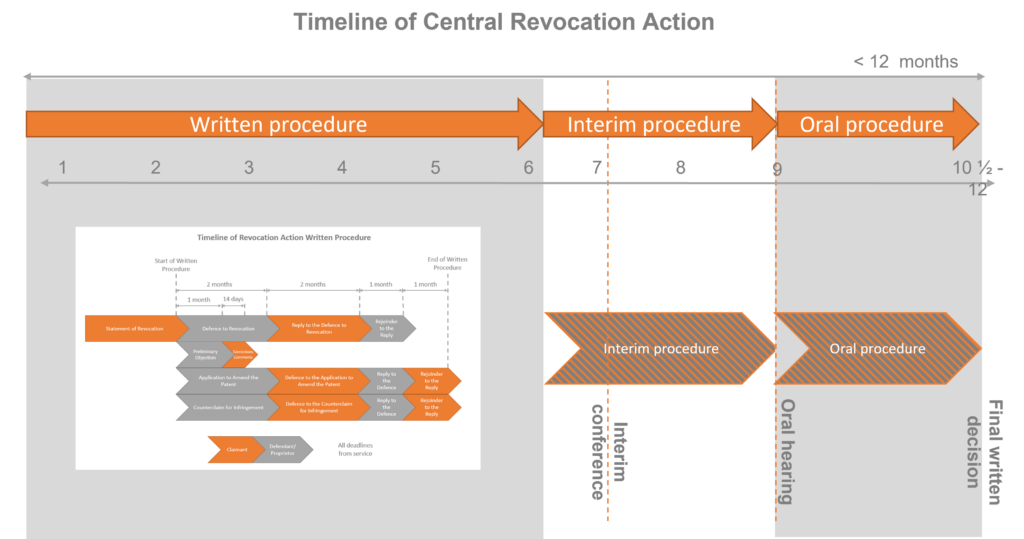30/05/2023
With the new Unified Patent Court (UPC) opening its doors on 1 June 2023, we take a look at what to expect if you are involved in proceedings before the UPC.
One of the oft-cited reasons for choosing litigation before the UPC is the speed, although whether the new court will be able to keep to the 12 to 14 month timeline for issuing decisions at first instance, as set out in the Rules of Procedure, remains to be seen. Keeping to these timelines may be especially challenging at the start of the new court, with pent-up demand resulting in a flurry of actions being filed on, or shortly after, 1 June.
First instance proceedings
Both first instance revocation and infringement proceedings consist of a written procedure, an interim procedure and an oral procedure (Art. 52(1) UPCA).
Although the specific timelines differ for revocation proceedings and infringement proceedings, a final written decision is expected for both types of proceedings within less than 14 months. Indeed, for revocation proceedings where no counterclaim for infringement is filed, a final written decision may be expected in less than 12 months.
Revocation actions
We have previously compared oppositions before the EPO with central revocation actions before the UPC. Below, we set out the procedure for revocation actions before the UPC in more detail.
Written procedure in revocation actions
In the written procedure, the parties’ pleadings are exchanged. The Statement for Revocation is filed by the Claimant, and will be served on the Defendant by the Registry of the UPC (Rule 6 Rules of Procedure of the UPC). The Defendant is given one month to lodge Preliminary Objections (e.g. to challenge the competence of the UPC to hear the case, or the language of the Statement for Revocation), and two months to file a Defence to Revocation (R.49(1)). The Defence may comprise an Application to Amend the Patent (R.43(2)(a)) and a Counterclaim for Infringement (R.43(2)(b)).
As in opposition and appeal proceedings before the EPO, auxiliary requests are permissible before the UPC when filing an Application to Amend the Patent (R.30(1)(a)).
Following service of the Defence to Revocation, the Claimant is given two months to file a Reply to the Defence, and any Defence to the Application to Amend and to the Counterclaim for Infringement (R.51).
The Defendant may then file a Rejoinder to the Reply within one month of service, together with any Reply to the Defence to the Application to Amend and to the Counterclaim for Infringement (R.52). Within one month of service, the Claimant may lodge a Rejoinder to the Reply to the Defence to the Counterclaim together with any Rejoinder to the Reply to the Defence to the Application to amend the patent (R.56(4)).
This concludes the written procedure, subject to possible exchange of further pleadings (R.58). As can be seen, the written procedure allows for a number of rounds of argument between the parties, as well as the filing of auxiliary requests. In this manner, revocation actions before the UPC bear great resemblance to oppositions before the EPO and the experience of patent attorneys at oppositions will no doubt prove invaluable.

Interim procedure
Following the written procedure, the interim procedure begins. During the interim procedure, the judge-rapporteur makes the necessary preparations for the oral hearing (R.101). The parties may be ordered by the judge-rapporteur to clarify arguments, answer specific questions, produce evidence, or lodge specific documents (R.103(1)).
An interim conference may be held (R.101(1)), with a strong preference for the interim conference to be held by telephone or video conference (R.105(1)). The interim conference aims, inter alia, to identify the main issues and determine which relevant facts are in dispute (R.104(a)). To what extent the judge-rapporteur will take a proactive approach to case management at the interim conference is still unknown. However, given the target of a single day for oral hearings, the interim conference may be a good opportunity for the judge-rapporteur to focus a dispute to the key points.
The interim procedure shall be concluded within three months of the end of the written procedure (R.101(3)).
Oral procedure
Following the interim procedure, the oral procedure begins. The judge-rapporteur summons the parties to the oral hearing taking place before the panel, giving the parties at least two months’ notice (R108), unless agreed otherwise by the parties.
It is the intention of the Court to conclude the oral hearing within a single day (R.113(1)). This highlights the importance of the written procedure and the parties’ written pleadings during proceedings before the UPC. To enable such swift oral hearings, the presiding judge of the panel hearing the case is provided with broad powers to limit parties’ submissions to specific issues and time limits (R.113), though the possibility of a separate hearing of witnesses is provided for (R.115). Such short hearings reinforce the importance of the written procedure for actions before the UPC. When combined with the short interim procedure – which will limit the opportunity to perform experiments, find expert witnesses, and so on – it seems likely that the Court will lean heavily on the technical judges. Given it is expected that majority of the technical judges will either be part-time or retired European patent attorneys or EPO examiners, having a European patent attorney on a litigation team will be important in revocation proceedings.
Decision
The Court’s decision may be given immediately after the closure of the oral hearing, with reasons provided on a subsequent date (R.118(7)). Given the complex nature of many patent disputes, it seems unlikely that many decisions will be announced in this manner. More likely, the Court shall give its decision in writing as soon as possible, and within six weeks of the oral hearing (R.118(6)).

According to the UPC Rules of Procedure, a final written decision should thus be available within 10 ½ months from service of the Statement for Revocation if the oral hearing is scheduled soon enough during the written or interim procedure. In any event, a decision may be expected within no more than 12 months.
Infringement actions
As noted above, infringement proceedings consist of a written procedure, an interim procedure and an oral procedure (Art. 52(1) UPCA).
Written procedure in infringement actions
The written procedure in infringement actions closely mirrors the written procedure in revocation proceedings.
A Statement of Claim is filed by the Claimant, with the Defendant given one month to lodge Preliminary Objections (e.g. to challenge the competence of the UPC to hear the case, or the language of the Statement of Claim). The Defendant is then given three months to file a Defence to the Statement of Claim (R.23). Notably, this is a month longer than the period for filing a Defence to a Statement of Revocation, which is only two months. The Defence may comprise a Counterclaim for Revocation (R.25).
As with revocation actions, the Claimant in an infringement action is given two months to file a Reply to the Defence following service, and, if there is a counterclaim, to file a Defence to the Counterclaim for Revocation and any Application to Amend the Patent (R.29(a)).
The Defendant may then file a Rejoinder to the Reply within one month of service (R.29(c)). However, if there is a Counterclaim for Revocation, the Defendant is given two months from service to file the Rejoinder to the Reply together with a Reply to the Defence to the Counterclaim and a Defence to the Application to Amend (R.29(d)).
Within one month of service, the Claimant may then file a Rejoinder to the Reply to the Defence to the Counterclaim, and a Reply to the Defence to the Application to Amend (R.29(e)). Finally, the Defendant may file a Rejoinder to the Reply to the Defence to the Application to Amend the patent within one month of service of the Reply (R.32(3)). In each case, the Rejoinders are limited to a response on the matters raised in the respective Replies.

Interim procedure/Oral Procedure/Decision
For infringement actions, the interim procedure, oral procedure, and final written decision in infringement actions closely mirror those in revocation actions.

Taking into account the longer written procedure compared with revocation actions, a final written decision should be expected within no more than 14 months.
Summary
As highlighted above, perhaps the most important aspect of UPC procedure for any user of the system to be aware of is the very short timeframe in which cases are intended to be concluded. This will be a challenge for both users of the system as well as the Court itself, particularly if a large number of actions are filed shortly after the UPC comes into effect on 1 June 2023.
But as well as challenges, the short timings offer some interesting opportunities. For example, the six-month written procedure of a revocation action could well be completed before the nine-month opposition window closes for revoking a European patent. This means a party can run their arguments before the UPC (and see the patentee’s defence) before even having to file a parallel opposition before the EPO. Such insight is not an insignificant advantage and may be well worth the €20k court fees considering an opposition could knock out the patent in all countries, not just UPC states.
What is certain, however, is that patent attorneys and lawyers representing clients in UPC actions will have to be able to respond quickly and advise their clients decisively. With over 80 European patent attorneys and technical assistants in the UK and on continental Europe, Reddie & Grose has both the resources and expertise to manage and run revocation and infringement actions before the UPC.
This article is for general information only. Its content is not a statement of the law on any subject and does not constitute advice. Please contact Reddie & Grose LLP for advice before taking any action in reliance on it.




